Buying a capo is easy. Choosing the best one is a bit more difficult. I should know. The first time I had to chose a capo to buy, it took me weeks before I finally decided on one. While this device may seem simple enough, there are several things that should be at the top of your mind. It also doesn’t help that there are literally hundreds of capo brands, each offering many different types and models.
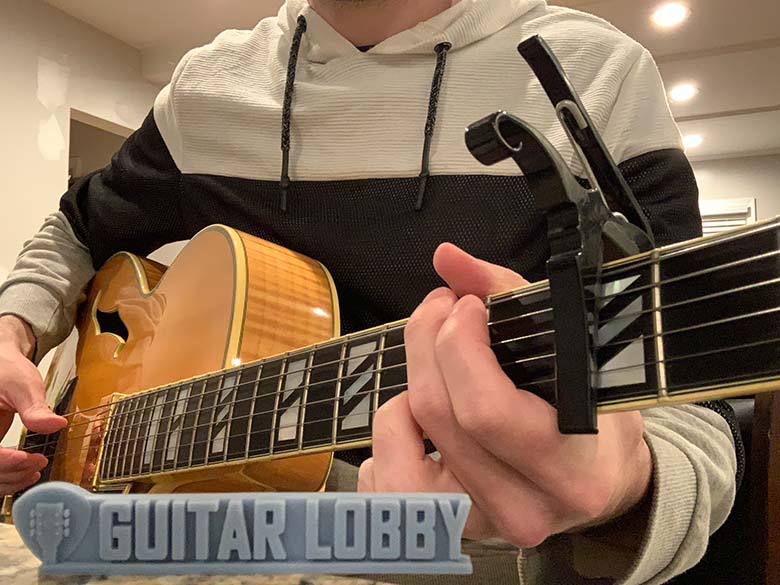
Given that my initial foray into the world of capos had been very challenging, I came up with this comprehensive review and buying guide. I’ll start this article by reviewing the best guitar capos at different price points, but if you want to learn more about them before reading reviews, check out our guitar capo buying guide at the bottom of the page here.
| Name of Product | Image of Product | Description | Price Range | Full Review |
|---|---|---|---|---|
| 1. G7th Performance 3 Capo with ART (Best Overall) | 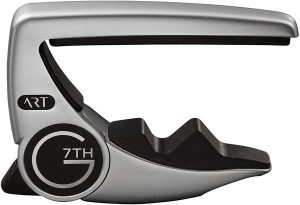 | Type: Clutch Weight: 1.7 oz. | $50 | Read Full Review Below |
| 2. WINGO Rosewood Guitar Capo (Best Value) | 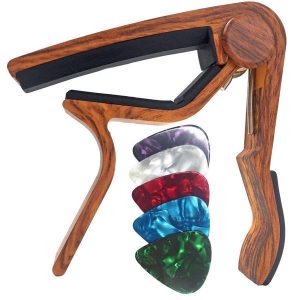 | Type: Trigger Weight: 0.2 oz. | $10 | Read Full Review Below |
| 3. Kyser KG6B Quick-Changed Capo (Best Trigger Capo) | 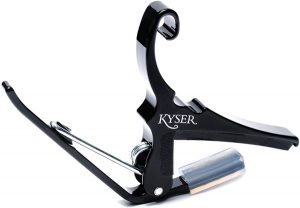 | Type: Trigger Weight: 0.16 oz. | $20 | Read Full Review Below |
| 4. Donner DC-2 One Handed Trigger Guitar Capo (Best Spring Capo) |  | Type: Spring Weight: 3.17 oz. | $10 | Read Full Review Below |
| 5. AmazonBasics Zinc Alloy Guitar Capo (Best Budget Capo) | 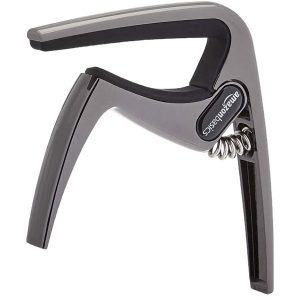 | Type: Spring Weight: 3.04 oz. | $10 | Read Full Review Below |
| 6. Dunlop Trigger Curved Guitar Capo | 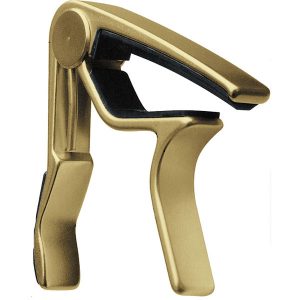 | Type: Trigger Weight: 2.4 oz. | $20 | Read Full Review Below |
| 7. GuitarX X Capo | 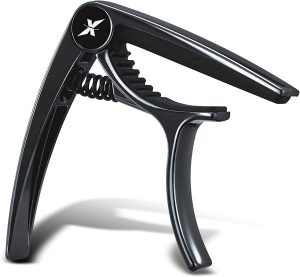 | Type: Spring Weight: 3.2 oz. | $15 | Read Full Review Below |
| 8. Creative Tunings SpiderCapo Standard | 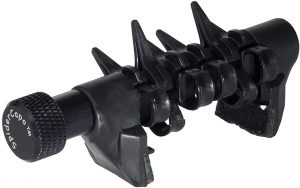 | Type: Full-partial Weight: <1.0 oz. | $30 | Read Full Review Below |
| 9. D’Addario NS Tri-Action Capo | 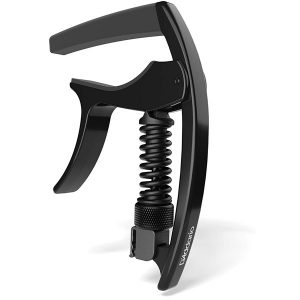 | Type: Trigger Weight: 0.288 oz. | $15 | Read Full Review Below |
| 10. Paige P6E 6-String Acoustic Capo | 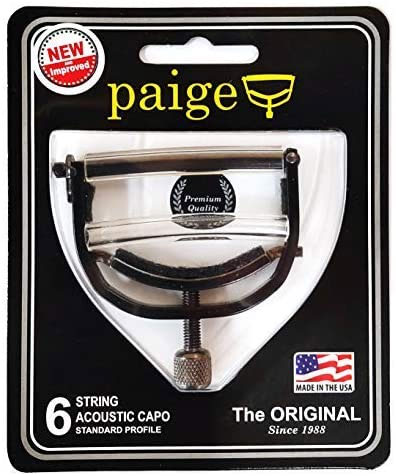 | Type: Screw, Yoke-type Weight: 1.6 oz. | $25 | Read Full Review Below |
| 11. Dunlop 14C Professional Toggle Capo | 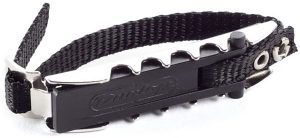 | Type: Toggle Weight: 0.64 oz. | $5 | Read Full Review Below |
| 12. Shubb S1 Guitar Capo | 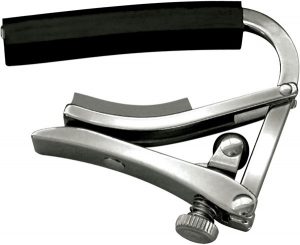 | Type: Screw Weight: 0.32 oz. | $20 | Read Full Review Below |
| 13. Kyser KG3B Short-Cut Partial Capo | 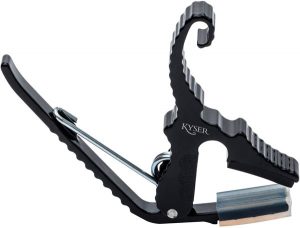 | Type: Partial, trigger Weight: 0.638 oz. | $20 | Read Full Review Below |
| 14. D’Addario Planet Waves NS Guitar Capo | 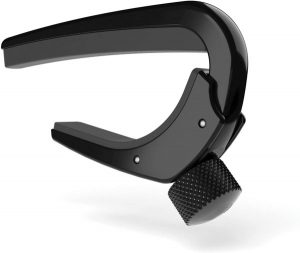 | Type: Screw Weight: 1.44 oz. | $15 | Read Full Review Below |
| 15. Dunlop 7191 Bill Russell Elastic Heavy Capo | 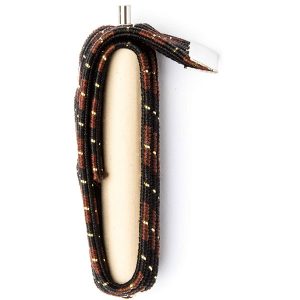 | Type: Strap Weight: 0.8 oz. | $10 | Read Full Review Below |
| 16. WINGO Wide Guitar Capo | 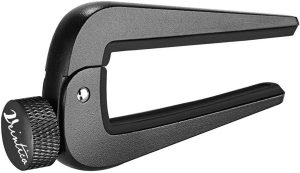 | Type: Screw Weight: 0.2 oz. | $15 | Read Full Review Below |
| 17. Wuxic Shark Capo | 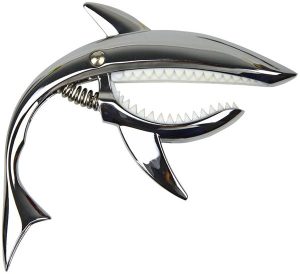 | Type: Spring Weight: 3.2 oz. | $10 | Read Full Review Below |
Here Are the Best Guitar Capos
1. G7th Performance 3 Capo with ART (Best Overall)
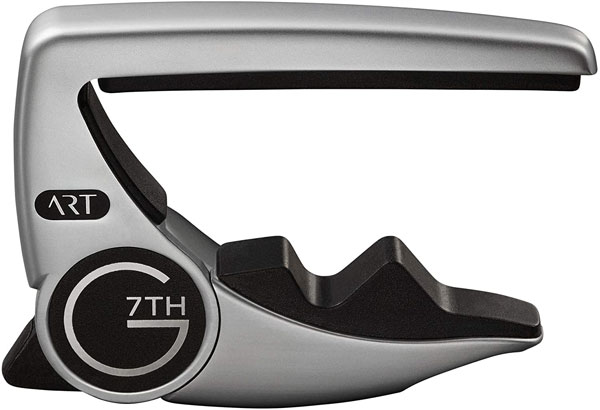
| Estimated Price | $50 |
| Type | Clutch |
| Weight | 1.7 oz. |
| Adjustable Tension | Yes |
| One-handed Operation | Yes |
| Material | Stainless steel |
| Good for | Steel-string acoustic and electric guitars; nylon-string hybrid guitars |
My Review: This is the third generation of G7th’s revolutionary Performance Capos, which the company introduced in 2004. That state-of-the-art guitar accessory won numerous accolades and I wouldn’t be surprised if the Performance 3 will be reaping more awards for the English organization.
The Performance 3 has all the things you want in a capo. You want precision adjustment, maximum tuning stability, optimum versatility, and ease of use? This capo has it. What I really love about this capo is its Adaptive Radius Technology. Most capos only work on flat or curved fretboards with a certain fingerboard radius. The Performance 3 works on all fretboard shapes. You get equal pressure across the strings and give you a more permanent-like nut on any fret.
Putting the capo on any guitar is also effortless. A simple squeeze is all it takes to open the capo and slide it over your fretboard. There are no screws to tinker. G7th designed the Performance with the ultimate in effortless and precision tension control. All strings will receive the correct amount of force necessary to produce the correct tension. That’s what I call ingenious.
Bottom Line: The G7th Performance 3 with ART may be the most expensive on this list. However, it simply is the best when it comes to build quality, tuning stability, ease of use, versatility, convenience, and tension control.
2. WINGO Rosewood Guitar Capo (Best Value)
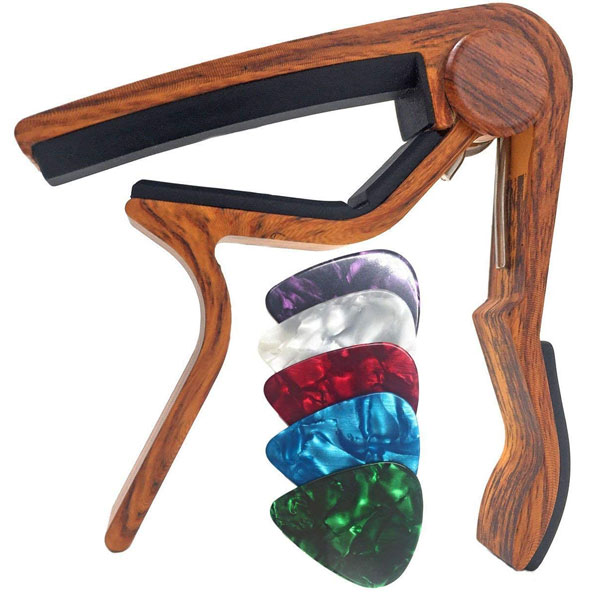
| Estimated Price | $10 |
| Type | Trigger |
| Weight | 0.2 oz. |
| Adjustable Tension | No |
| One-handed Operation | Yes |
| Material | Aluminum alloy with wood finish |
| Good for | Acoustic, bass, and electric guitars; ukulele |
My Review: While the WINGO looks like any other guitar capo, I find its wood finish to be very appealing. I must warn you, though, that this is not authentic wood. It is more of a laminate that WINGO placed over an aluminum alloy frame. It does lend the capo an elegance that I find very pleasing on certain acoustic guitars.
Like all trigger capos, the WINGO doesn’t allow for the adjustment of the string tension. There’s no worry there because this capo applies well-balanced pressure across the strings. The spring mechanism looks solid enough that I suspect this baby will last many years of continuous gigs. While the spring is strong, it doesn’t take that much effort to open the capo and place it on your guitar.
I also like the fact that the capo has a thicker bar than other capos on the market. At least, you’ll feel more confident about protecting the finish of your guitar. WINGO is also throwing in 6 pieces of faux tortoiseshell guitar picks to make your guitar playing even more awesome. Now that’s what I call great value.
Bottom Line: The WINGO Rosewood Guitar Capo offers exceptional value for the money. It is perfect for beginner guitarists who want a capo that’s easy to use, performs as expected, and is friendly on the pocket.
3. Kyser KG6B Quick-Changed Capo (Best Trigger Capo)
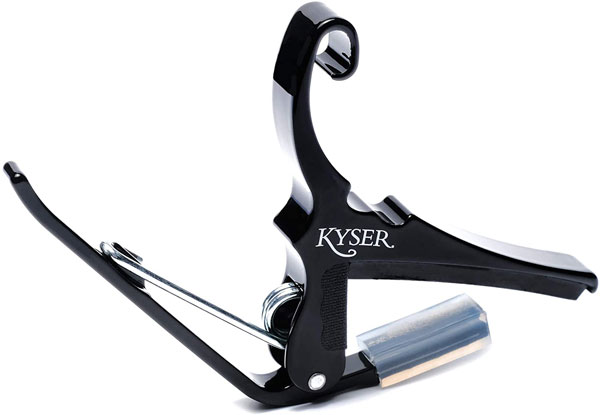
| Estimated Price | $20 |
| Type | Trigger |
| Weight | 0.16 oz. |
| Adjustable Tension | No |
| One-handed Operation | Yes |
| Material | Aluminum |
| Good for | Acoustic guitars |
My Review: The KG6B may be pricier than other trigger type capos on the market. However, there are a few good reasons for it. First, the steel coil spring that forms the clamping mechanism of the capo is a lot thicker than the spring found in other products. This gives you the strength that you need to apply tension on the springs. What surprised me is the ease of opening and manipulating the KG6B. I would have expected it to be difficult to open because of its strong spring.
Second, the capo didn’t create any unwanted buzz no matter how I repositioned it across the fretboard. It latches into place like a secondary nut, allowing me to play my favorite songs on the fly. Third, I love the curled design of the capo’s arm. It looks like a clef that can be a very pleasant reminder about what I am passionate about.
Fourth, there are 23 colors to choose from. It’s very easy to pick a capo that best suits your style. Lastly, the aluminum construction makes this baby a featherweight. Be careful, though. A capo this light is easy to lose.
Bottom Line: You will be paying more for this trigger type of capo. However, every penny you spend is worth it because of the KG6B’s professional-grade performance, lightweight characteristics, ease of use, and a stylish design.
Popular Related Article: The Best and Most Comfortable Guitar Straps Out There Right Now
4. Donner DC-2 One Handed Trigger Guitar Capo (Best Spring Capo)
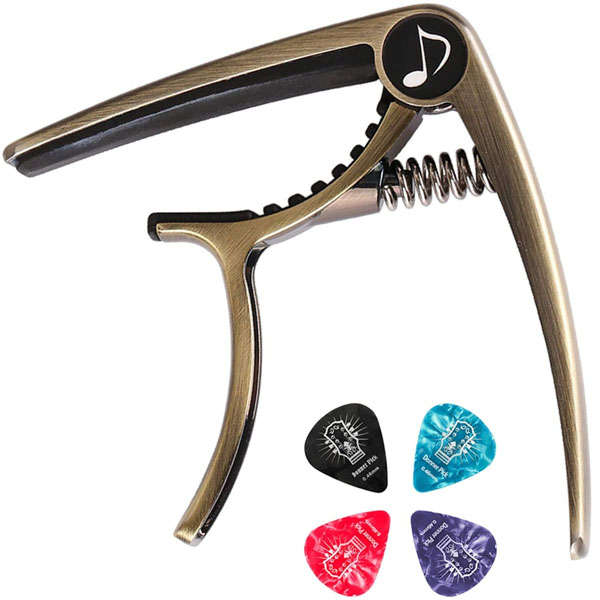
| Estimated Price | $10 |
| Type | Spring |
| Weight | 3.17 oz. |
| Adjustable Tension | No |
| One-handed Operation | Yes |
| Material | Zinc alloy |
| Good for | Acoustic and electric guitars, ukulele |
My Review: If you’re a huge fan of spring capos, I highly recommend Donner’s DC-2. One of the things that I love about the DC-2 is its memory spring. I can place this device on any string instrument, regardless of the shape and dimensions of the neck. Place it on a U-, C-, or even a V-shaped guitar neck and the DC-2 will fit right in.
There’s another reason why I like the DC-2’s memory spring. This innovation allows the DC-2 to apply balanced force across the strings. Each string receives the correct tension, allowing the capo to eliminate unwanted buzz. This also helps keep the strings in tune, regardless of how frequently I replace the capo over the neck.
Speaking of placement, the DC-2 is easy to secure and slide across the neck. This is despite its very strong spring. I also like the clean finish of the capo. I find it ideal for anyone who believes in simplicity when it comes to capos. Unfortunately, it is quite heavy. It’s still good news for those who have a habit of losing or misplacing their capos simply because the device is too light.
Bottom Line: For its amazing features, sleek looks, and unquestionable performance, the DC-2’s price tag is a steal. I haven’t seen a capo as beautiful and high-performance as the Donner DC-2.
5. AmazonBasics Zinc Alloy Guitar Capo (Best Budget Capo)

| Estimated Price | $10 |
| Type | Spring |
| Weight | 3.04 oz. |
| Adjustable Tension | No |
| One-handed Operation | Yes |
| Material | Zinc alloy |
| Good for | Acoustic and electric guitars |
My Review: You’ve got to love how Amazon is leveling the playing field by offering consumers with good quality and affordable products that it can support its customer service platform. In fact, this is the main advantage of getting this capo from AmazonBasics. Not only do you have a reliable capo to use on any guitar. You also have the full backing of the e-commerce giant.
This capo is not the most affordable spring type device on the market. However, its premium-quality zinc alloy construction is reassuring enough that you get more than what your money’s worth. It feels very solid and the spring looks like it can last several years of abuse.
I like the simple design and the seamless finish of this capo. The tension is just right, allowing you to play any song without having to hear that annoying buzz. It is also very easy to put on the guitar and move it anywhere along the fretboard. The black looks elegant, although I find the copper to be very striking. You can also pick the silver if that complements your guitar better.
Bottom Line: This AmazonBasics capo may not have a revolutionary technology or a cutting-edge design that can set it apart from the rest. However, it does a great job of clamping your guitar strings on the fly with ease. If you’re looking for the best capo for acoustic guitars and are on a low budget, this is an awesome choice. It also works great for electric guitars too.
6. Dunlop Trigger Curved Guitar Capo
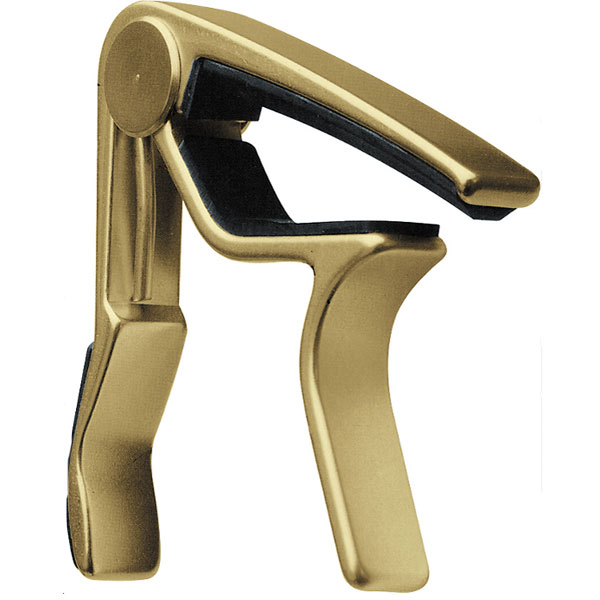
| Estimated Price | $20 |
| Type | Trigger |
| Weight | 2.4 oz. |
| Adjustable Tension | No |
| One-handed Operation | Yes |
| Material | Aluminum |
| Good for | Acoustic and electric guitars |
My Review: I know I’m not the only one who admires the many musical accessories that JIM DUNLOP designs and manufactures. Their products are acclaimed for their stylish looks and functionality. And while there are now more design-aggressive brands that are taking the guitar-loving world by storm, Dunlop remains the choice of seasoned musicians and artists. You’ll feel like a pro the moment you decide to pick this capo for your guitar.
This product is a bit pricier than other trigger capos on the market. I think you’re paying a premium for the brand name. All is good, as the capo has a very solid build and feels right on the hand. It doesn’t feel like some cheap plastic, although some folks may think otherwise. I like the fact that it has a very simple design. The color options are just right for conservative folks like me.
I’m surprised at how strong the spring mechanism is. Once you clamp it on the fretboard, it will never budge. What amazed me, even more, is the ease of capo removal. This is surprising because a spring this strong should not make it easy to remove the capo. But, it does!
Bottom Line: This trigger capo is perfect for die-hard Dunlop fans. It is simple, easy to operate, beautiful, and performs a lot better than other trigger capos on the market.
Popular Related Article: The Top Guitar Amps Out There Right Now
7. GuitarX X Capo
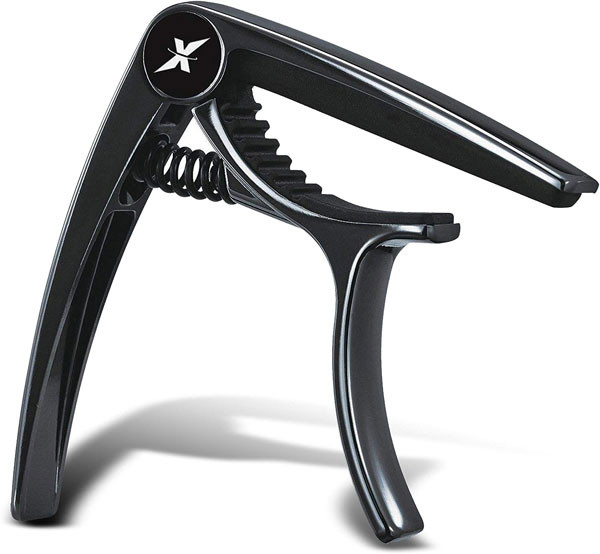
| Estimated Price | $15 |
| Type | Spring |
| Weight | 3.2 oz. |
| Adjustable Tension | No |
| One-handed Operation | Yes |
| Material | Zinc alloy |
| Good for | Acoustic and electric guitars; ukulele, mandolin, banjo |
My Review: Guitar X is one of the most versatile capos you can ever buy. You will not be able to adjust the tension on your strings. However, this is never a problem with GuitarX X. The company utilized a unique memory spring that allows the capo to apply only the correct force on the strings. Regardless of the kind of string instrument that you have, you can easily maintain its tuning characteristics.
One of the most important benefits of this simple technology is the more effective elimination of the annoying fret buzz. You’ll get crisp sounds whenever you play your guitar, no matter where you place the GuitarX on the fingerboard. Moving it is also never an issue. While the spring is made of high-grade steel, GuitarX still managed to make the opening mechanism as effortless as possible.
I adore the slim design of this capo. It is hefty, which is good if you’re the type of guitarist who doesn’t notice if his capo already fell from his pocket. The silicone grip is also a nice touch as it can help safeguard the aesthetics of your guitar.
Bottom Line: While it is not the best capo around, the GuitarX X still makes for a great accessory to any string instrument. It performs better than expectations and will never scratch your precious guitar.
8. Creative Tunings Spider Standard
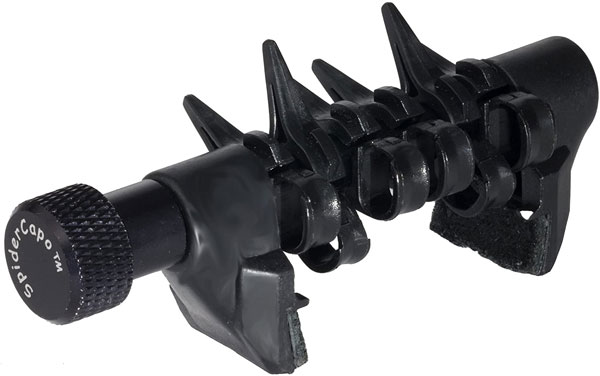
| Estimated Price | $30 |
| Type | Full-partial |
| Weight | <1.0 oz. |
| Adjustable Tension | Yes |
| One-handed Operation | No |
| Material | No information |
| Good for | Acoustic, classical, and electric guitars |
My Review: This capo has got to be the most ingenious accessory you can ever buy for your guitar. I love to call it the full-partial capo, depending on how you use it. The SpiderCapo looks like a clamp with individual pegs for each string on a guitar. If you want to use it as a full capo, then you can easily activate all six pegs over the fingerboard.
I find the SpiderCapo’s design to be revolutionary. It gives you the versatility you need to decide on which strings you want to have a different key. I believe songwriters and adventurous guitar players will love this. They can create new chords, fascinating tones, and remarkable melodies. Newbie guitar players will love it, too. I can almost see them nailing the barre chords with very little effort.
The SpiderCapo has a screw mechanism on top that allows you to adjust the tension of the pegs. Say goodbye to fret buzz and other annoying sounds. The only downside is that you will need both hands to slide the capo along the neck, manipulate the tension pegs, and secure the capo in place.
Bottom Line: I wouldn’t mind paying several tens of dollars for this amazing piece of capo. It is the perfect tool for unleashing a musician’s creativity, while also helping novice guitarists master the art of fingerings.
9. D’Addario NS
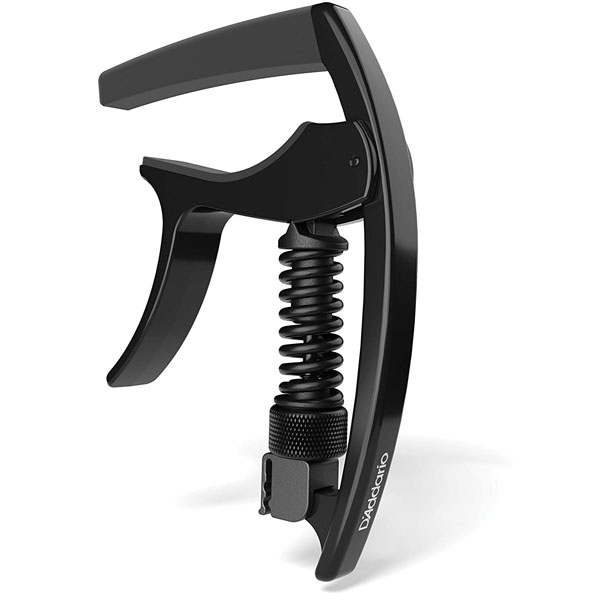
| Estimated Price | $15 |
| Type | Trigger |
| Weight | 0.288 oz. |
| Adjustable Tension | Yes |
| One-handed Operation | Yes |
| Material | Aluminum |
| Good for | Acoustic and electric guitars |
My Review: D’Addario has been making guitar strings, capos, straps, and other accessories for musical instruments since 1974. You can say that they already have a firm grasp of what customers really need. This is what the NS Tri-Action capo brings to the table. It looks like a screw type of capo. However, I can tell you that it isn’t. This is a trigger capo that behaves more like a screw type capo.
The opening and clamping mechanism is that of a trigger capo. This makes sure you will never have to fuss about having to move the capo along the neck. The disadvantage of a conventional trigger capo is that you cannot adjust the tension. This is where the screw-type micrometer tension adjustment mechanism of the NS Tri-Action comes to the fore. This technology allows for the equal distribution of pressure across the strings, regardless of your instrument. It gives the guitar a clear tune and ring.
It’s easy to place in the pocket and the integrated pick holder is ingenious.
Bottom Line: The NS Tri-Action is perfect for guitar players who love the ease of use of a trigger capo and the precision tension adjustment of a screw type of capo. It also helps that the capo is lightweight and has almost the same price as a conventional trigger or screw capo. If you’re looking for the best capo for electric guitars and want something a little less expensive this one will work great. It works just fine for acoustic guitars as well.
10. Paige P6E

| Estimated Price | $25 |
| Type | Screw, Yoke-type |
| Weight | 1.6 oz. |
| Adjustable Tension | Yes |
| One-handed Operation | Partial |
| Material | Nickel-plated Brass |
| Good for | Acoustic guitars |
My Review: The yoke-type capo has been around since the late 18th century. If you’re the type of guitarist who prefers old-school guitar accessories, I cannot think of a better capo than Paige’s P6E. This is a yoke capo that is a sub-type of screw capos. However, it would be wrong to think that it performs like the capos of the old world.
Paige designed the P6E with the best materials possible. The main capo is high-quality brass and plated in nickel to give the capo a more modern look. The bar features a unique silicone material that will never harm your guitar, while also ensuring optimum pressure on the strings of your acoustic guitar. It’s also amazing that the P6E is easy to slide along the neck, making it a one-handed operation. Putting it on your guitar requires both hands, however.
The P6E works like any other screw capo. It allows you to make very fine adjustments to the tension on your strings. Just slowly make the adjustments and you’d hit the sweet spot. You can always say goodbye to that nasty buzzing sound produced by ill-fitting capos on your guitar.
Bottom Line: The Paige P6E is a blast-from-the-past guitar capo with enough contemporary design elements that ensure optimum guitar performance. Guitarists who have a thing for vintage products should consider this capo.
11. Dunlop 14C
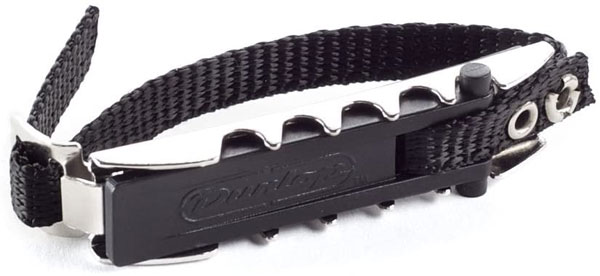
| Estimated Price | $5 |
| Type | Toggle |
| Weight | 0.64 oz. |
| Adjustable Tension | Yes |
| One-handed Operation | No |
| Material | Nickel-plated steel |
| Good for | Acoustic and electric guitars |
My Review: Jim Dunlop never knew that his brand would become a household name when he entered the business of making tuners, capos, and other guitar accessories in the 1960s. One of the company’s first guitar capos was the 1100-series toggle capo. It was a remarkable piece of contraption that has slowly grown out of favor through the years. The toggle is making a comeback with several improvements in the 14C Professional Toggle Capo.
There are two models of the 14C. One is for curved fingerboards and the other one is for flat fretboards. What makes this toggle capo very different from its past iterations is the fact that it is more secure. The toggle mechanism positive clamping to help you eliminate the buzz. You may think that the 14C will not allow tension adjustment. On the contrary, it is very easy to adjust the pressure on the strings.
I appreciate the simplicity of the 14C as well as its low-profile design. It will never get in the way of your fingerings. It doesn’t cost that much, too.
Bottom Line: This is a 20th century capo with enough 21st century elements to give old-fashioned guitarists a few good reasons to ditch their trigger or spring capos. It is very easy to use, easy on the budget, and won’t pose any hindrance to your jamming.
12. Shubb S1
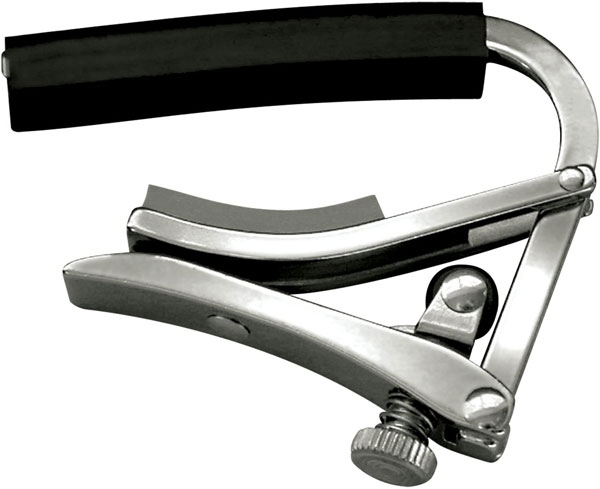
| Estimated Price | $20 |
| Type | Screw |
| Weight | 0.32 oz. |
| Adjustable Tension | Yes |
| One-handed Operation | Yes |
| Material | Stainless steel |
| Good for | Acoustic and electric guitars |
My Review: Shubb is synonymous with high-performance screw capos. The company designed a capo that has become the envy of others, producing knockoffs and second-rate products. However, Shubb continues to push the limits of innovation by reinforcing a time-tested design. This is the S1. It is a screw capo that many companies try to copy, only to find themselves failing in the process.
What I truly like about the Shubb S1 is its ‘set-it, forget-it’ kind of adjustable tension mechanism. Most of the screw capos we have on the market tend to ‘forget’ the amount of pressure that a certain set of guitar strings require. You need to reset it every time you put the capo on the guitar. That’s not going to happen with the S1. This capo lets you set it once and you’re ready to rock.
Some of the screw capos on the market are also quite difficult to lock and remove. The S1 has a lever that you flip, allowing you to remove and/or replace the capo along the fretboard. The rubber is custom-made. It’s great for keeping the perfect tune of your guitar.
Bottom Line: The Shubb S1 is a capo that’s very easy to use and will never disrupt the fine tuning of your guitar. It can give you more confidence in your guitar-playing than other capos on the market.
13. Kyser KG3B
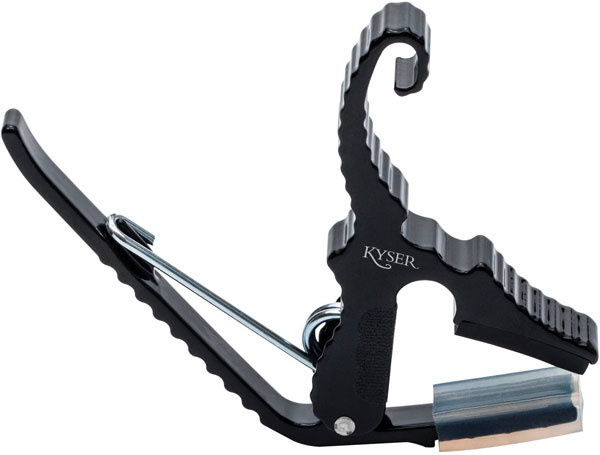
| Estimated Price | $20 |
| Type | Partial, trigger |
| Weight | 0.638 oz. |
| Adjustable Tension | No |
| One-handed Operation | Yes |
| Material | Aluminum |
| Good for | Acoustic and electric guitars |
My Review: Consider this the ‘small brother’ of the Kyser KG6B. The KG3B has the same unique, curled styling of the guitar clamp and the same solid and strong spring mechanism. The difference is that the KG3B is a 3-string partial capo. Its ‘bigger brother’, the KG6B, is a 6-string full capo.
I believe that the KG3B is perfect for advanced guitarists who are more than ready to take their guitar playing to another level. The KG3B capo will only cover two possible 3-string combinations. Positioning the capo on the low note side (6th string) of the fretboard will cover the 5th, 4th, and 3rd strings. Flipping the capo so that it clamps on the high note side (1st string) of the guitar will cover the 2nd, 3rd, and the 4th strings.
The KG3B is like the Kyser KG6B. The hardware is exactly what you would expect from this reputable company. The trigger design of the capo also allows for ease of handling. The tension, while not adjustable, is enough to keep the strings in their position without ever creating a buzz.
Bottom Line: This is one capo that is best reserved for those who have a more adventurous spirit in terms of exploring the different possibilities that the guitar fingerboard can offer. It is the perfect device for anyone who wishes to unleash his musical creativity.
14. D’Addario Planet Waves NS
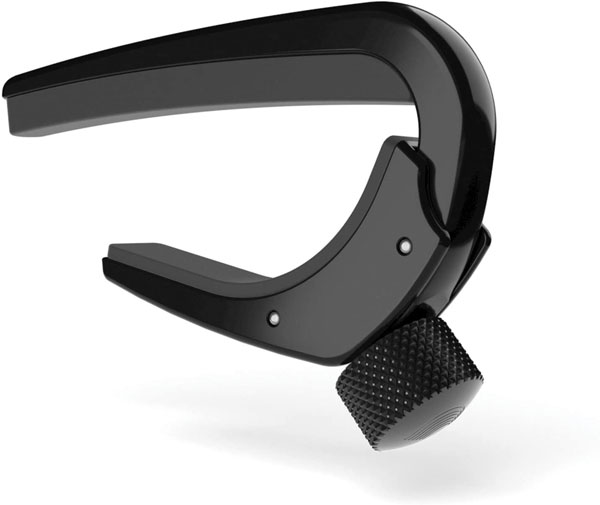
| Estimated Price | $15 |
| Type | Screw |
| Weight | 1.44 oz. |
| Adjustable Tension | Yes |
| One-handed Operation | Yes |
| Material | Aluminum |
| Good for | Acoustic and electric guitars |
My Review: I love the D’Addario Planet Waves NS. It has a very streamlined design that is perfect for those who do not want distractions on the guitar while playing. The minimalist design of the Planet Waves also addresses the common issue of not being able to perform fingering movements in a more effective manner because of the obtrusive design of conventional capos.
The Planet Waves slides and gets secured into place by its tactile-friendly knob. What you don’t see is an ingenious spring mechanism that incorporates D’Addario’s revolutionary micrometer tension adjustment system. You’ll never have to worry about any buzzing sound from your guitar whenever you put on the capo. The Planet Waves NS clamps onto the strings like a vise grip with only the right force to create the correct string tension.
Your guitar can produce vibrant and clear tones and none of that bothersome buzz. One potential downside to the Planet Waves NS is its size and weight. It is quite easy to lose this capo if you don’t have a secure solution to store it in. I suggest having a special pouch for it.
Bottom Line: You’ll never go wrong with this D’Addario capo. It has a nice combination of high performance, precision tensioning, effortless use, and budget-friendliness in a slim and sleek profile that feels right at home in your pocket.
15. Dunlop 7191 Bill Russell Elastic Heavy Capo
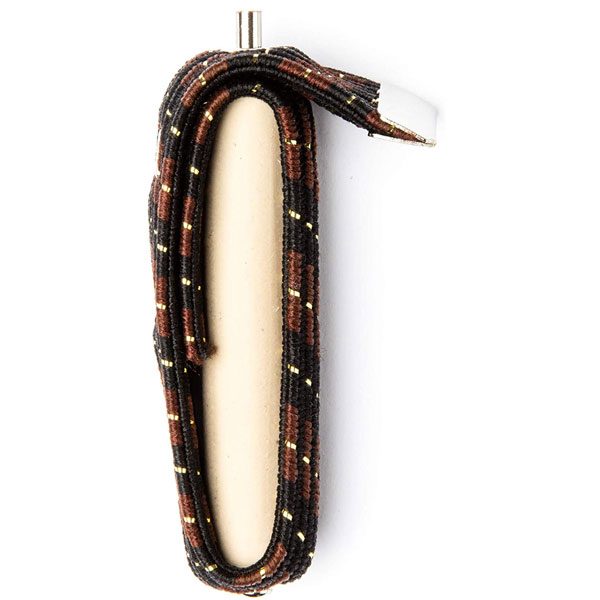
| Estimated Price | $10 |
| Type | Strap |
| Weight | 0.8 oz. |
| Adjustable Tension | Yes |
| One-handed Operation | No |
| Material | Elastic strap |
| Good for | Acoustic and electric guitars; ukulele, banjo |
My Review: Most of the capos today is either a trigger or a spring type. However, there are still guitarists who can appreciate the simplicity and effectiveness of an old-school strap capo. The Dunlop 7191 Bill Russell Elastic Heavy Capo is perfect for such guitar players. We may not be huge fans of the strap capo. However, once you try the Bill Russell on your guitar, you might want to ditch your traditional capo for this one.
The Bill Russell capo has a simple design that belies its amazing ability to create an arbitrary nut anywhere along the fretboard. It is not that easy to manipulate when compared to spring or trigger capos. Nevertheless, it addresses this shortcoming by improving on its ability to exert even and constant pressure on all strings.
It would be a mistake to think that the capo bar is also made of an elastic strap. This capo sure has a super-strong elastic material. However, it also has a good-quality stainless steel that forms the skeleton for its silicone rubber material. This helps ensure you retain the ideal tuning of your guitar.
Bottom Line: The Dunlop 7191 Bill Russell is the perfect capo for old-school guitar players who clearly don’t have a need for any of the high-tech gadgets we have today. It’s simple, inexpensive, and it lets you transpose on the fly.
16. WINGO Wide Guitar Capo
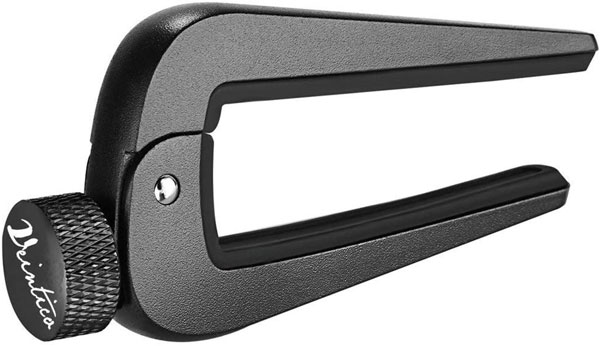
| Estimated Price | $15 |
| Type | Screw |
| Weight | 0.2 oz. |
| Adjustable Tension | Yes |
| One-handed Operation | Yes |
| Material | Zinc alloy |
| Good for | Acoustic, classical, bass, and electric guitars; ukulele, mandolin, banjo |
My Review: Some of you may be put off by the fact that WINGO Music is a Chinese manufacturer. However, this is a Chinese brand that is making a good name for itself when it comes to the design and production of good-quality professional guitar accessories. It should not be surprising why the WINGO Wide Guitar Capo is performing so well in different e-commerce platforms.
The WINGO Wide looks like the D’Addario Planet Waves NS, except that the Wingo has a sharper angle. It looks like a tuning fork without the handle. The Planet Waves, on the other hand, resembles more like an elegant letter C with an elongated upper curve. The design gives the Wingo capo a slimmer profile.
Performance-wise, the WINGO is on par with the PW. You get uniform pressure across the strings to eliminate fret buzz. Adjusting the tension is also easy because of the textured knob. What I find amazing is that it has two different bar shapes. One arm has a flat bar that is perfect for classical guitars. The other arm has a curved bar for acoustic and electric guitars with a fingerboard radius of about 2.25 inches.
Bottom Line: The dual bar shape of the WINGO is what gives it a unique advantage over other screw capos. It’s light on the pocket and effortless to handle, too.
17. Wuxic Shark Capo
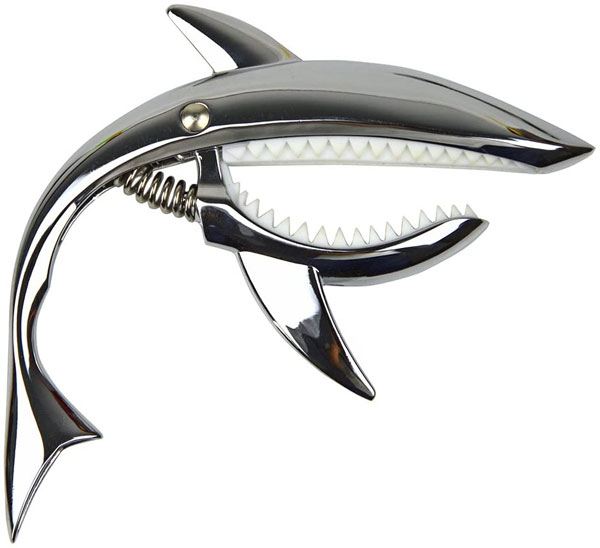
| Estimated Price | $10 |
| Type | Spring |
| Weight | 3.2 oz. |
| Adjustable Tension | No |
| One-handed Operation | Yes |
| Material | Zinc alloy |
| Good for | Acoustic, electric, bass, and folk guitars; ukulele, mandolin, banjo |
My Review: The Wuxic Shark works like any other spring type capo. It relies on its solid and strong spring system to open and clamp down on the strings of an acoustic, electric, or even a folk guitar. You can also use this capo on your banjo, mandolin, and ukulele for kids and kids-at-heart.
The main attraction of the Wuxic capo is its whimsical shark design. I like the way how the jaws of the Shark were transformed into the capo clamp. The hinge serves as the eye and the inverted pectoral and dorsal fins serve as the grip for the capo. It is available in gold, red gold, gray, silver, and blight black. Personally, you can pick any color as each one looks very elegant.
Beyond the aesthetics of the Wuxic is a clamp mechanism that will never deaden your strings nor create an irritating buzz. It has a memory spring that takes care of the tension requirements of your strings. The shark teeth-designed capo bar also secures the strings to produce a clear and distinct guitar sound. And since the Wuxic Shark is a trigger type of capo, placing and moving it along the length of the neck is never an issue.
Bottom Line: The Wuxic Shark Capo may not be the device you’d want to use for your live gigs. However, its aesthetic appeal, affordability, reliable performance, and ease of use make this capo a sure hit as a gift.
Choosing the Right Guitar Capo (Buying Guide)
If you’re a novice guitar player searching for his very first capo, then this section is for you. Seasoned guitarists can also learn a thing or two from this comprehensive guide to buying and using a guitar capo. Most of you here are probably looking for a capo for your acoustic guitar, but capos can also be used on electric guitars. Keep in mind that there really is no difference between an acoustic guitar capo and an electric guitar capo. The only reason you’ll see those two terms used is for marketing purposes.
What is a Capo?
A capo is a very simple device that allows guitarists to raise the pitch of their guitar without changing the shape of the chord played. The main effect of the capo is the creation of a new and temporary nut. This shortens the playable length of the guitar strings.
For beginners, the nut is that hard section at the junction between the neck and the headstock of the guitar. This is where the strings get anchored before they get distributed to the 6 (or 12) capstans or string posts in the headstock. As such, you can play the entire length of the string across the neck.
Placing a capo on any fret will produce an arbitrary nut. You will only get to play the length of strings only up to this point. And since the length of the strings has been shortened, they also vibrate with greater frequency. This produces a higher pitch than the original length of the strings.
Why You Should Use a Guitar Capo
One of the most compelling reasons why you should get a capo is that it allows you to play a song in a different key without ever changing the chord shape of the original key. In other words, you can transpose almost any other key on the fly.
For example, you know how to play a song in the key of C. A friend of yours wants to sing along, but his voice is better suited for the key of D. A capo on the 2nd fret lets you play the same chords in the key of C while producing the sounds of the key of D. Do take note that this only works for open chords.
Advanced beginners can also use the capo to add layers to their guitar playing, especially if they love jamming with their friends. If all of you will be playing the exact chord shapes in the exact same key, you’ll end up with a less than appealing melody. If one of you will be playing the same chord shape in a different key, then you’ll add a different sonic layer. The sound you produce will be more harmonious.
A capo can also help unleash your musical creativity. You can experiment with different tunes. This is helpful for budding songwriters. The capo gives you versatility without having to make very significant changes to your guitar’s tuning.
Kids and people who may have short limbs can also benefit from the use of a capo. Since the capo moves the ‘nut’ closer to the body, these people will not have to strain to the far end of the fretboard. They can accomplish the chords about a third from the headstock or even all the way in the middle of the neck.
Types of Gutiar Capos
Learning about the different types of capos is crucial to making a wise decision as to the best capo to buy.
Strap Capos
These are the simplest forms of capos. The bar gets secured over the fretboard by an elastic strap. It is very easy to use and allows for easy sliding across the fretboard. The problem is that it can slip from its position and affect the tune of your guitar.
Toggle Capos
You can think of toggle capos as a slightly improved version of the strap capo. There is an additional mechanism that allows you to secure the strap tight. This helps prevent the capo from getting displaced. Unfortunately, the tension of the toggle mechanism can also affect the tune of the strings.
Trigger Capos
Most of the capos that we see in the market are of this type. People also call it the clamp capo. Think of the chip clip you use for resealing a bag of your favorite potato chips and you have an idea about the clamping mechanism of a trigger capo. A coil spring keeps the capo in the closed position. The opposite ends of the spring keep the capo closed.
The main advantage of a trigger capo is its ease of use. You can easily reposition it, using only one hand. Unfortunately, if you have weak hands, then it will be a problem. The tension of the spring is also non-adjustable.
Spring Capos
These look a lot like a trigger capo, in that they also use a spring. However, the design and positioning of the spring are different. It looks more like a ticket puncher.
Like the trigger capo, a spring capo is easy to use and manipulate with one hand. The spring also feels more solid than the trigger capo. The main issue is that the tension on the strings tends to be greater on the side where the capo is clamped on.
Screw Capos
This is one of the best types of capos. The addition of a screw allows one to adjust the tension of the bar over the strings, regardless of fret position, neck size, and string action. This can help keep the tuning of the guitar a lot better. The only downside to such a capo is the effort you must put in placing and securing the device on your guitar.
There is a special type of screw capo that people call the Shubb capo, after the company that designed the device in 1980. It is a hybrid that combines the speed and ease of use of a trigger type and the flexibility and precision of a screw type of capo.
Another variant of a screw capo is the yoke-style. It looks like the handle grip of a shovel with the hole encircling the thickness of the neck. A screw at the bottom secures the capo to the neck.
Clutch Capos
These are revolutionary guitar capos that do not have additional levers, not screws to tighten. This makes clutch capos unobtrusive to guitar playing. Clutch capos will never pull the strings and make them out of tune.
They are also adjustable. As a matter of fact, they are the easiest to fine-tune the tension adjustments. The tension mechanism of clutch capos is unique. You can place the device on any fret and it will retain its position, regardless of how furious you play your guitar.
Partial Capos
These capos cover only certain strings at a time. For example, they may only press on the 3 upper strings or the 3 lower strings of a guitar. There are also those that only cover 1 or 2 strings.
Partial capos are a very rare type of capos. This is perfect for advanced and seasoned guitarists who may want to give their songs different resonances, fingerstyles, and even chord voicings. However, I think the partial capo is also good for beginners, players with special needs, and even children who are courageous enough to venture into an exciting new frontier.
Factors to Consider when Buying a Capo
The type of guitar capo is one of the most important considerations when buying a capo. However, it is not the only factor that you need to think about. You should also consider the following in the determination of the type, brand, and model of capo that you need to buy.
Full or Partial Capo?
A full capo covers the width of the fretboard. This shortens all the guitar strings and allows you to play your guitar in any key. About 99 percent of all guitarists use this kind of capo. The remaining 1 percent use a partial capo.
A partial capo only shortens a few strings at a time. As such, only the pitch of these strings is changed. You might be interested in a partial capo if you are ready to explore the different fingerboard possibilities.
Fretboard Radius
Guitar fretboards or fingerboards can have either a curved or a flat surface. For example, the fretboard of nylon-string acoustic guitars is flat. On the other hand, the fretboard of steel-string acoustic guitars has a curved shape.
Curved fingerboards can also differ across guitar manufacturers. This is dependent on the manufacturer’s fingerboard radius. A guitar with a 9.5-inch fingerboard radius will have a slightly ‘flatter’ fretboard than a guitar with a 7.25-inch fingerboard radius.
Why does this matter when choosing a capo? Well, the curvature of the capo bar should match the curvature of the fretboard as defined by its fingerboard radius. A mismatch can lead to the inner or outer strings to stretch out of tune. These strings can also buzz and give you a very different tone.
If you have several guitars that have different fingerboard shapes, then I strongly recommend getting a capo with an adjustable design. This will allow you to use the same capo on any guitar, regardless of its fingerboard radius. Another option is to get a capo with interchangeable capo bars or feet. You can remove the bar and snap a new one to accommodate your guitar’s fingerboard radius.
Guitar Neck Dimensions
Not only do guitars differ in the shape and curvature of their fretboard. They can also differ in the size of their necks. There are guitars that have a very slim neck, especially near the headstock. There are also guitars that have a wide neck, while others are narrow. Some are thick and others are thin.
The capo that you buy should fit well over the neck of your guitar. Make sure that you have an idea about the capo’s guitar neck dimension requirements before you decide to buy.
Spacing of the Strings
This is not a concern if you are going to purchase a full capo. If it is a partial capo that you want, then you may want to look at the spacing of the strings on your guitar.
For example, a 3-string partial capo may work on a nylon-string acoustic guitar, clamping 007770. However, the same partial capo may not be suitable for an electric guitar with a narrow neck and a very curved fretboard.
Material of the Capo Bar
Here’s a factor that very few beginning guitarists consider when picking a capo. The capo bar typically consists of a rubber material. Depending on the hardness or softness of the rubber, you can get different tones.
Soft rubber can deaden the tone of the guitar a little bit. However, such a type of rubber can also mute the guitar strings a lot better without having to apply too much force. A soft rubber capo bar is often ideal for a 12-string guitar. It can stop the octave strings of the lower four courses more efficiently than hard rubber.
Force of Capo Clamping Mechanism
The force applied by a capo on the strings is also a very important consideration. It should not be too light nor too strong. You need to find the perfect balance to make it easier to tune your guitar.
A slightly out of tune guitar is often the result of a very tight capo. This is especially true for the bass strings. These strings have a larger diameter or are thicker than the treble strings. Because they are thicker, the force of the capo on the bass strings is greater than on the treble strings.
The force applied by a capo is also dependent on the design of the guitar neck. In general, necks are thinner and narrower near the headstock than they are near the guitar body. If you use a fixed-force capo, there is a tendency to apply greater force as you move away from the headstock. Open-jaw capos allow you to apply slightly more force on either the bass side or the treble side of the strings.
Type of Guitar String
Did you know that the thickness (or thinness) and action of the guitar string can also be a major factor in choosing the right capo?
The action of the string refers to its height relative to the surface of the fretboard. As such, a thick string will have less action because its outer surface will be nearer to the fretboard’s surface than that of a thin string.
If your guitar has light or thin strings and has normal action, you can pick a spring capo. This type of capo may not be ideal for medium and thick guitar strings and those that have high action.
Convenience
If you’re giving a capo to your kid, then you might want to consider a screw capo. Spring or trigger capos may not be ideal for them because of the amount of force needed to open these devices. The same is true for guitarists who may have diminished hand strength. In general, a capo should be very easy to put on and remove from your guitar, while retaining its ability to shorten the strings.
You may also want to consider a capo with a replaceable bar. The rubber in capos doesn’t last a lifetime. They dry out, harden, and become very brittle. It would also be nice if the capo came with a feature that allows for easy storage.
Weight
Capos are small. That doesn’t mean some of them will not feel like having a block of iron in your pocket. Inexpensive capos typically come in either plastic or anodized aluminum. These are perfect for putting in your pocket; although, you do tend to lose them easily. The heavy ones come in brass and even exotic wood. While these don’t get lost that easily, they can be a problem when in your pocket.
Style
You might want to pick a capo that best suits the aesthetics of your guitar or even your personal fashion sense. I have seen some capos designed like a shark, dolphin, and even an alligator. Of course, you can always go old school or even pick one that has an inconspicuous design.
Any guitarist should have a good and reliable capo. It is a small device that belies its amazing capabilities. Picking the right device can help unleash your musical creative potential. Jamming with your friends will be a cinch. Playing guitar solos like the pros is also now more possible than ever. So, pick a capo from this list. And if you think you want to do the search yourself, then my buying guide should steer you in the right direction.
Get that capo today and start playing your guitar like you’ve never played before!

My name is Chris and I’ve had a passion for music and guitars for as long as I can remember. I started this website with some of my friends who are musicians, music teachers, gear heads, and music enthusiasts so we could provide high-quality guitar and music-related content.
I’ve been playing guitar since I was 13 years old and am an avid collector. Amps, pedals, guitars, bass, drums, microphones, studio, and recording gear, I love it all.
I was born and raised in Western Pennsylvania. My background is in Electrical Engineering, earning a Bachelor’s degree from Youngstown State University. With my engineering experience, I’ve developed as a designer of guitar amplifiers and effects. A true passion of mine, I’ve designed, built, and repaired a wide range of guitar amps and electronics. Here at the Guitar Lobby, our aim is to share our passion for Music and gear with the rest of the music community.

A little disappointing that an Elliot didn’t even get a mention. Neither a BSC. You obviously haven’t used either.